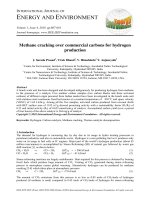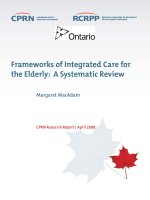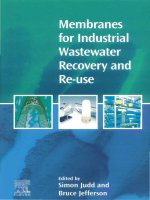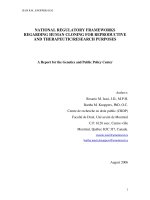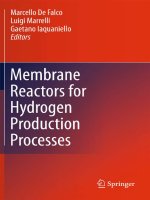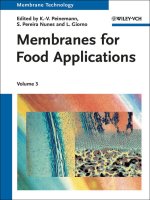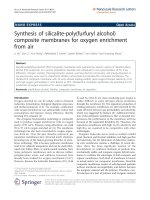Zeolitic imidazolate frameworks polybenzimidazole nanocomposite membranes for hydrogen purification
Bạn đang xem bản rút gọn của tài liệu. Xem và tải ngay bản đầy đủ của tài liệu tại đây (3.71 MB, 234 trang )
ZEOLITIC IMIDAZOLATE FRAMEWORKS/
POLYBENZIMIDAZOLE NANOCOMPOSITE MEMBRANES
FOR HYDROGEN PURIFICATION
YANG TINGXU
NATIONAL UNIVERSITY OF SINGAPORE
2012
ZEOLITIC IMIDAZOLATE FRAMEWORKS/
POLYBENZIMIDAZOLE NANOCOMPOSITE MEMBRANES
FOR HYDROGEN PURIFICATION
YANG TINGXU
(B. Eng., Shanghai Jiao Tong University, P. R. China)
A THESIS SUBMITTED
FOR THE DEGREE OF DOCTOR OF PHILOSOPHY
NUS GRADUATE SCHOOL FOR INTEGRATIVE
SCIENCES AND ENGINEERING
NATIONAL UNIVERSITY OF SINGAPORE
2012
i
ACKNOWLEDGEMENTS
I wish to take this opportunity to express my sincere appreciation to all the
contributors during my years in the National University of Singapore. First of all, I am
especially grateful to my supervisor, Professor Chung Tai-Shung, Neal, for his
generously guidance and support without hesitation. Over the past three years, he has
added value to me with numerous opportunities and well-equipped research facilities.
He has trained me as an independent researcher and enlighten me to achieve more
than what I ever expect.
I wish to express my gratefully thanks to my mentor, Dr. Xiao Youchang, who has
provided invaluable advice, inspiration and encouragement to me during my starting
period of PhD candidate. Without him, I may undergo a harder time for the first year,
and a significant portion of the work included herein may not have been achieved. I
also appreciate the assistance from my TAC members, Professor Zeng Hua Chun and
Dr. Pramoda Kumari Pallathadka, for their valuable comments and discussions. I
would like to acknowledge the research scholarship by the NUS Graduate School of
Integrative Sciences and Engineering (NGS) and thank the Singapore National
Research Foundation (NRF) for the financial support that enables this work to be
successfully completed. I am also thankful to Ms. Tricia Chong and Ms. Yong Yoke
Ping for their kindest advice and help during the patent documentation.
I would like to convey my appreciation to all members of Prof. Chung‘s group,
especially Ms. Wang Huan, Mr. Chen Hangzheng, Mr. Li Fuyun, Miss Chua Mei
Ling, Dr. Low Bee Ting, Mr. Ong Yee Kang, Dr. Dave William Mangindaan, Dr. Su
ii
Jincai, Mr. Wang Peng, Miss Xing Dingyu, Dr. Wang Rongyao, and many others for
plenty of good times, discussion and sharing of knowledge. Special thanks are due to
Mr. Shi Gui Min for all his kind cooperation and help in the laboratory. Finally, I
must express my deepest gratefulness to my family for their endless support,
especially to my dearest husband Jiye for his unfailing love, patience, and
understanding during the three and a half years period of 5450 km long-distance
relationship.
iii
TABLE OF CONTENTS
ACKNOWLEDGEMENTS i
TABLE OF CONTENTS iii
SUMMARY ix
NOMENCLATURE xi
LIST OF TABLES xiv
LIST OF FIGURES xvi
CHAPTER 1 INTRODUCTION 1
1.1 Hydrogen for industrial feed and sustainable development 2
1.2 Membrane technology for gas separation 5
1.3 Diversity of membrane materials 9
1.3.1 Polymers 9
1.3.2 Inorganics 10
1.3.3 Organic-inorganic hybrids 12
1.4 Gas transport mechanism 14
1.5 Membrane fabrication and structures 18
1.6 Types of membrane module configurations 19
1.7 Process and cost optimization 21
1.8 Research objectives and organization of dissertation 23
1.9 References 27
CHAPTER 2 LITERATURE REVIEW 34
iv
2.1 Membrane material design principles for hydrogen purification 35
2.2 H
2
-selective polymeric membranes for hydrogen purification 36
2.3 CO
2
-selective polymeric membranes for hydrogen purification 40
2.4 Polybenzimidazole based membranes for gas separation 41
2.5 ZIFs based crystalline membranes and mixed matrix membranes 44
2.6 Particle synthesis and dispersion methods for mixed matrix membranes 46
2.7 Challenges and future prospects 48
2.8 References 50
CHAPTER 3 METHODOLOGY 58
3.1 Materials 59
3.1.1 Polymers and solvents 59
3.1.2 ZIFs synthesis agents 60
3.2 ZIFs nanoparticle synthesis 60
3.2.1 ZIF-7 nanoparticle synthesis 60
3.2.2 ZIF-8 nanoparticle synthesis 61
3.2.3 ZIF-90 nanoparticle synthesis 62
3.3 Membrane fabrication and post treatment protocols 63
3.3.1 ZIFs/PBI dense films 64
3.3.2 Co-extrusion of ZIF-8-PBI/Matrimid dual-layer hollow fibers 64
3.4 ZIFs nanoparticles and membranes characterization 65
3.4.1 Dynamic light scattering (DLS) 65
3.4.2 Transmission electron microscope (TEM) 66
3.4.3 Field emission scanning electron microscopy (FESEM) 66
3.4.4 Wide-angle X-ray diffraction (XRD) 67
v
3.4.5 Nuclear magnetic resonance spectroscopy (NMR) 67
3.4.6 Fourier transform infrared spectroscopy (FTIR) 68
3.4.7 Thermo gravimetric analysis (TGA) 68
3.4.8 Positron annihilation lifetime spectroscopy (PALS) 68
3.4.9 Positron annihilation spectroscopy (PAS) 69
3.4.10 Differential scanning calorimetry (DSC) 70
3.4.11 Density measurement 70
3.5 Determination of gas transport properties 71
3.5.1 Pure gas permeation 71
3.5.2 Mixed gas permeation 73
3.5.3 Measurements of gas sorption 76
3.6 References 78
CHAPTER 4 ZIF-7/PBI NANO-COMPOSITE MEMBRANES FOR HYDROGEN
PURIFICATION 81
4.1 Introduction 82
4.2 Results and discussion 86
4.2.1 ZIF-7 particle dispersion in the PBI matrix 86
4.2.2 Characterizations 91
4.2.3 Gas transport properties 96
4.3 Conclusions 101
4.4 References 102
vi
CHAPTER 5 ZIF-8/PBI NANO-COMPOSITE MEMBRANES FOR HIGH
TEMPERATURE HYDROGEN PURIFICATION CONSISTING OF
CARBON MONOXIDE AND WATER VAPOR 112
5.1 Introduction 113
5.2 Results and discussion 117
5.2.1 Characterizations 117
5.2.2 Pure gas transport properties at ambient temperature 121
5.2.3 Membrane performance at high temperature mixed gas tests 124
5.2.4 Effects of CO and water vapor on mixed gas separation performance 128
5.3 Conclusions 132
5.4 References 134
CHAPTER 6 ZIF-90/PBI NANO-COMPOSITE MEMBRANES FOR HYDROGEN
PURIFICATION 143
6.1 Introduction 144
6.2 Results and discussion 145
6.2.1 Characterizations of ZIF-90 nanocrystals 145
6.2.2 Characterizations of ZIF-90/PBI nano-composite membranes 150
6.2.3 Pure gas transport properties at ambient temperature 152
6.2.4 Mixed gas performance at high temperatures 155
6.3 Conclusions 158
6.4 References 161
CHAPTER 7 ZIF-8-PBI/MATRIMID DUAL-LAYER HOLLOW FIBER
MEMBRANES FOR HYDROGEN PURIFICATION 165
vii
7.1 Introduction 166
7.2 Experimental 170
7.2.1 Spinning dope formulation 170
7.2.2 Co-extrusion of the dual-layer hollow fiber membranes and solvent
exchange 172
7.3 Results and discussion 174
7.3.1 As-synthesized ZIF-8 particle properties 174
7.3.2 ZIF-8/PBI symmetric dense membranes 175
7.3.3 Morphology of the asymmetric dual-layer hollow fiber membranes 178
7.3.4 Influence of particle loadings and spinning conditions on gas transport
properties 182
7.3.5 Mixed gas separation performances from ambient to high temperatures . 186
7.4 Conclusions 189
7.5 References 191
CHAPTER 8 CONCLUSIONS AND RECOMMENDATIONS 202
8.1 Conclusions 203
8.1.1 A review of the research objectives of this work 203
8.1.2 ZIFs/PBI nano-composite materials design and fabrication 203
8.1.3 Evaluation of membrane performances in industrially modeling conditions
206
8.1.4 Fabrication of ZIF-8-PBI/Matrimid hollow fibers 207
8.2 Recommendations and future work 208
8.2.1 Plasticization phenomenon in ZIFs/PBI membranes at high pressures 208
8.2.2 Optimization of hollow fiber spinning conditions 208
viii
8.2.3 Thin layer doping of ZIFs/PBI material on a porous substrate 209
PUBLICATIONS 210
ix
SUMMARY
Hydrogen production is a large and fast expanding industry. In the petroleum and
chemical industries, large quantities of H
2
are needed for processing heavy crude oil
into useable fuels, producing ammonia for fertilizer and other industrial uses. Due to
the growing global awareness of energy security and sustainability, hydrogen has
attracted much industrial attention as an effective and green energy carrier. The
demand for hydrogen is driven by the need for refiners to expand production and
comply with environmental regulations being progressively introduced around the
world. In the large scale hydrogen production, carbon dioxide is the main by-product
of the water-gas shift reaction. It must be captured to produce high purity H
2
and
eliminate environmental concerns.
Comparing with traditional separation methods, membrane based separation
technologies show the advantages of environmental friendlier, smaller footprint, and
less energy deduction. Among materials for separation membrane fabrication,
polymers remain to be the most practical and economical choice. However, the
effective separation of H
2
and CO
2
mixtures is challenging because most polymers
show undesirable counterbalance characteristics of H
2
-selective diffusivity and CO
2
-
selective solubility. In addition, most of the polymeric membranes cannot survive or
keep good H
2
/CO
2
separation performance in harsh industrial environments which
contain high temperature and pressure, and impurities in the gas streams.
x
Mixed matrix membranes (MMMs) consisting of polymeric materials and inorganic
components have the potential to achieve higher selectivity, permeability, or both
relative to the raw polymeric membranes. However, challenges such as pore blockage,
chain rigidification and interface voids still exist and restrain the potential separation
performance of MMMs materials. In addition, the oversize and agglomeration of
nano-particles limit their applications in fabricating practical membrane
configurations such as asymmetric hollow fibers.
In this work, a group of ZIFs/PBI nano-composite materials have been developed for
high temperature hydrogen purification. Membranes were formed via a novel
procedure by incorporating as-synthesized wet-state zeolitic imidazolate frameworks
(ZIFs) nano-particles into a polybenzimidazole (PBI) polymer. The resultant ZIFs/PBI
nano-composite membranes show very encouraging H
2
/CO
2
separation performance
and excellent stability under elevated temperatures. Intensive investigations were
carried out on (1) conducting fundamental studies for deeply understanding the
science and engineering of this material and membrane formation technology, (2)
fabricating this material into industrially useful membrane configuration-hollow fiber,
by optimizing the nano-particle loadings, spinning conditions, and post treatment
methods, and (3) examining the practical applicability by various performance tests
under different operating parameters such as high temperatures and impurities
commonly contained in the syngas streams. Based on our observation, this newly
developed H
2
-selective membrane material may have bright prospects for hydrogen
purification and CO
2
capture in realistic industrial applications such as syngas
processing, integrated gasification combined cycle (IGCC) power plant and hydrogen
recovery.
xi
NOMENCLATURE
A Effective area of the membrane available for gas transport
b Langmuir affinity constant
C Local penetrant concentration in the membrane
C
D
Penetrant concentration in Henry‘s sites
C
H
Penetrant concentration in Langmuir sites
C
H
‘ Langmuir capacity constant
D Outer diameter of the testing fibers
D Diffusion coefficient
dp/dt Change of pressure with time in the downstream chamber of the
permeation cell
d Average d-space
d
k
Kinetic diameter of the gas molecule
E
D
Activation energy for diffusion
E
P
Activation energy of permeation
ΔH
S
Enthalpy of sorption
I
3
Intensity
k
D
Henry‘s law constant
L Membrane thickness
L Effective length of the modules
l Thickness of a membrane selective layer
M Molecular weight
M
W
Molecular weight of the gas component
xii
M
WA
Molecular weight of gas A
M
WB
Molecular weight of gas B
N Steady state flux of the permeating gas at standard temperature
and pressure
n Number of fibers in one testing module
P Permeability coefficient of a membrane to gas
P Atmospheric pressure
P
0
Pre-exponential factor for the activation energies of permeation
P
eff
Effective permeability of a gas penetrant in a mixed matrix
membrane
P
C
Gas penetrant permeabilities in continuous phase in mixed matrix
membrane
P
D
Gas penetrant permeabilities in dispersed (sieve) phases in mixed
matrix membrane
p Feed gas pressure in contact with the polymer
p
1
Downstream pressure
p
2
Upstream pressure
Δp Pressure different between the upstream and the downstream of a
membrane
P/L Permeance of a membrane to gas
Q Volumetric flow rate of pure gas
R Universal gas constant
R Hole radius
ΔR A fitted empirical electron layer thickness of 1.66Å
S Solubility coefficient
xiii
r Effective pore radius
T Absolute temperature
T
b
Boiling point
T
g
Glass transition temperature
t Permeation time
V Downstream reservoir volume
V
h
Cavity volume
w
0
The weight of the sample in air
w
1
The weight of the sample in hexane
x Gas molar fraction in the feed
y Gas molar fraction in the permeate
α
A/B
Ideal selectivity of component A over B
δ
D
Solubility parameter from dispersion interactions
δ
H
Solubility parameter from hydrogen bonding
δ
P
Solubility parameter from polar attraction
δ
T
Total solubility parameter
η Gas viscosity
θ X-ray diffraction angle of the peak
λ Mean free path of the gas penetrant
λ Wavelength of X-ray source
ρ
hexane
Density of hexane
ρ
membrane
Density of the membrane
τ
3
o-Ps lifetime
φ Volume fraction
φ
D
Volume fraction of dispersed (sieve) phase
xiv
LIST OF TABLES
Table 1.1 Properties of hydrogen 4
Table 1.2 Physico-chemical properties of a series of gaseous compounds most often
investigated in polymeric gas separation studies or industrial applications 8
Table 1.3 Gas transport properties of commercial polymers used for fabricating gas
separation membranes 9
Table 1.4 Key characteristics of the three major types of modules used for the
industrial applications of gas separation processes with polymeric
membranes 20
Table 2.1 Selected physical properties of H
2
and CO
2
35
Table 2.2 Representative H
2
and CO
2
intrinsic transport properties of H
2
-selective
membranes from commercial polymers 37
Table 2.3 Representative H
2
and CO
2
intrinsic transport properties of CO
2
-selective
membranes 40
Table 4.1 Thermo properties and particle loadings of pure PBI, ZIF-7 and ZIF-7/PBI
nano-composite membranes 93
Table 4.2 Positron annihilation lifetime spectroscopy (PALS) data of pure PBI and
ZIF-7/PBI nano-composite membranes 96
Table 4.3 Pure gas and mixed gas permeation properties of pure PBI and ZIF-7/PBI
nano-composite membranes with different ZIF-7 loadings at 35 ºC 97
Table 5.1 ZIF-8 particle loadings of the nano-composite membranes determined from
TGA 118
xv
Table 5.2 Pure and mixed gas separation performances of pure PBI and ZIF-8/PBI
nano-composite membranes at 35 °C 122
Table 5.3 P, D and S coefficents of CO
2
in pure PBI and ZIF-8/PBI nano-composite
membranes at 35 °C in 3.5 atm 123
Table 6.1 ZIF-90 particle loadings of the nano-composite membranes determined
from TGA 151
Table 6.2 Pure gas separation performance of pure PBI and ZIF-90/PBI nano-
composite membranes at 35 °C. 153
Table 6.3 P, D and S coefficients of CO
2
in pure PBI and ZIF-90/PBI nano-composite
membranes at 35 °C and 3.5 atm 154
Table 7.1 Spinning conditions of ZIF-8-PBI/Matrimid dual-layer hollow fiber
membranes 171
Table 7.2 Solvent-exchange procedures for dual-layer hollow fibers 173
Table 7.3 Pure gas separation performance of flat ZIF-8/PBI dense membranes 177
Table 7.4 Surface tension and solubility parameters of the solvents used for the
hollow fiber solvent-exchange processes in this study 180
Table 7.5 Pure gas permeation results of ZIF-8-PBI/Matrimid dual-layer hollow
fibers tested at 25 °C, 3.5 atm 183
xvi
LIST OF FIGURES
Figure 1.1 World energy consumption by fuel and the related carbon dioxide
emissions (1990-2035) 3
Figure 1.2 Schematic classification of membrane, related processes and separated
components 6
Figure 1.3 Market share in 2000 for membrane gas separations 7
Figure 1.4 Schematic diagram of a basic membrane gas separation process. 8
Figure 1.5 Schematic of mixed matrix membranes (MMMs) 13
Figure 1.6 Different gas transport routes through mixed matrix membranes (MMMs)
14
Figure 1.7 Solution-diffusion mechanism for a H
2
-selective dense polymeric
membrane 15
Figure 1.8 Schematics of gas transport mechanisms 17
Figure 1.9 Schematic drawing of the morphology, materials, and configuration of
technically relevant synthetic membranes 19
Figure 1.10 Membrane module configurations 20
Figure 1.11 A membrane process designed by MTR consisting both H
2
- and CO
2
-
selective membranes 22
Figure 2.1 Robeson upper bound for H
2
-selective polymeric membranes 36
Figure 3.1 Chemical structures of polymers in this study 60
Figure 3.2 Crystalline structures of ZIFs particles in this study 61
xvii
Figure 4.1 Chemical structures of poly-2,2'-(m-phenylene)-5,5' bibenzimidazole and
ZIF-7 87
Figure 4.2 Comparison of ZIF-7 particles size distribution under different conditions
89
Figure 4.3 Morphology images of ZIF-7/PBI nano-composite 90
Figure 4.4 The appearance of 50/50 (w/w) ZIF-7/PBI nano-composite membrane 91
Figure 4.5 FTIR spectra of pure PBI and ZIF-7/PBI nano-composite membranes 92
Figure 4.6 TGA thermograms of pure PBI, ZIF-7, and ZIF-7/PBI nano-composite
membranes under air atmosphere 93
Figure 4.7 XRD spectra of pure PBI, ZIF-7, and ZIF-7/PBI nano-composite
membranes 95
Figure 4.8 Comparison between the Maxwell predicted values and experimental data
of ZIF-7/PBI nano-composite membranes 98
Figure 4.9 Mixed gas permeation test results of pure PBI and ZIF-7/PBI nano-
composite membranes 99
Figure 4.10 H
2
/CO
2
separation performance of pure PBI and ZIF-7/PBI nano-
composite membranes compared to the Robeson upper bound 101
Figure 5.1 TGA thermograms of pure PBI and ZIF-8/PBI nano-composite
membranes under air atmosphere 118
Figure 5.2 FESEM images from cross-section views of a) 30/70 (w/w) ZIF-8/PBI and
b) 60/40 (w/w) ZIF-8/PBI membranes 120
Figure 5.3 EDX element mappings for C, N and Zn from the cross-section of 30/70
(w/w) ZIF-8/PBI membrane 121
Figure 5.4 CO
2
sorption isotherms of pure PBI and ZIF-8/PBI nano-composite
membranes 123
xviii
Figure 5.5 H
2
/CO
2
mixed gas permeation results of ZIF-8/PBI nano-composite
membranes 125
Figure 5.6 Temperature dependence on gas permeability (P) in ZIF-8/PBI nano-
composite membranes 127
Figure 5.7 H
2
/CO
2
separation performance of ZIF-8/PBI nano-composite membranes
compared to the Robeson upper bound 128
Figure 5.8 Effect of CO on H
2
/CO
2
mixed gas separation performance 130
Figure 5.9 Effect of water vapor content on H
2
/CO
2
mixed gas separation
performance 132
Figure 6.1 The particle distribution pattern of the as-synthesized ZIF-90 nanocrystals
measured by DLS 146
Figure 6.2 A FESEM image of ZIF-90 nanocrystals. (dry state powders) 147
Figure 6.3 XRD spectra of ZIF-90 powders and ZIF-90/PBI nano-composite
membrane comparing with literature data 148
Figure 6.4 The solid state
13
C CP/MAS NMR spectrum of ZIF-90 nanocrystals 149
Figure 6.5 The FTIR spectrum of pure ZIF-90 powders 150
Figure 6.6 FESEM images of the 45/55 (w/w) ZIF-90/PBI nano-composite
membrane 152
Figure 6.7 CO
2
sorption isotherms of pure PBI and ZIF-90/PBI nano-composite
membranes 154
Figure 6.8 H
2
/CO
2
mixed gas permeation results of ZIF-90/PBI nano-composite
membranes 155
Figure 6.9 Temperature dependence of gas permeability (P) in the 45/55 (w/w) ZIF-
90/PBI nano-composite membrane 157
xix
Figure 6.10 H
2
/CO
2
separation performance of ZIF-90/PBI nano-composite
membranes compared to the Robeson upper bound 158
Figure 7.1 Dual-layer spinneret scheme in this study 173
Figure 7.2 As-synthesized ZIF-8 particle distribution pattern from DLS measurement
175
Figure 7.3 XRD spectrum of ZIF-8/PBI nano-composite membrane comparing with
literature data 175
Figure 7.4 ZIF-8/PBI nano-composite membranes intrinsic gas separation
performances (35 °C) comparing with Robeson upper bound 177
Figure 7.5 Definition of hollow fiber sample name 179
Figure 7.6 Cross sectional views of hollow fibers with different solvent-exchange
procedures 180
Figure 7.7 FESEM images taken from the outer edge of a) PZM10-I B, b) PZM33-I
B hollow fibers 181
Figure 7.8 R parameters vs. positron incident energy in hollow fibers with different
solvent-exchange protocols 182
Figure 7.9 Comparison of selectivity vs. ZIF-8 loading patterns between symmetric
dense membranes and asymmetric dual-layer hollow fiber membranes . 185
Figure 7.10 Proposed scheme for gas transportation paths through the nano-
composite membranes comprising a lower and a higher particle loadings
185
Figure 7.11 H
2
/CO
2
(50/50) mixed gas permeation results of hollow fibers from
ambient to high temperature 188
1
CHAPTER 1
INTRODUCTION
2
1.1 Hydrogen for industrial feed and sustainable development
Energy and environmental sustainability are major long-term problems facing our
global economy. According to the anticipation in the latest International Energy
Outlook 2011 [1] by the U.S. Energy Information Administration, the world marketed
energy consumption will increase by 53 percent from 505 quadrillion British thermal
units (Btu) in 2008 to 770 quadrillion Btu in 2035. As shown in Figure 1.1(a) [1],
fossil fuels (liquids, coal and natural gas) will continue to dominate the energy
consumption in this prediction period. As more and more fossil fuels are consumed,
the fossil fuels would be depleted in a foreseeable future. Furthermore, the extensive
usage of fossil fuels, especially oil and coal with high carbon values, generates
greenhouse gases and toxic emissions which cause a series of detrimentally
environmental impacts including global climate disruption, sea level rise, and life
extinctions. As indicated in Figure 1.1(b) [1], the predicted world energy-related CO
2
emission will increase by 43 percent, from 30.2 billion metric tons in 2008 to 43.2
billion metric tons in 2035. There is an urgent demand to reduce the world‘s reliance
on fossil fuels and increase the sectors of alternative energy sources that are much
more environmental friendly.
3
(a)
(b)
Figure 1.1 World energy consumption by fuel and the related carbon dioxide
emissions (1990-2035)
(a) World energy consumption by fuel (quadrillion Btu); (b) World energy-related
carbon dioxide emissions by fuel (billion metric tons)
There are plenty of new primary energy sources available, such as nuclear breeders,
thermonuclear energy, solar energy, wind energy, geothermal energy, hydropower,
ocean currents, tides, and waves. The market share of alternative energy will expand
significantly since the related technologies become mature from the intensive research
and development over the past decades. Meanwhile, the sustained high oil prices also
allow alternative energy resources to become more economically competitive. At the
consumer end, about three-quarters of the primary energy is used as fuel and one-
quarter is as electricity [2]. Unfortunately, in contrast with the fossil fuels, none of the
above mentioned primary energy sources can be directly utilized as a fuel. Therefore,
the new primary energy sources must be converted to secondary energy carriers
needed by the consumer. The energy carrier of choice must satisfy the following
conditions [3]: 1) It must be convenient fuel for transportation; 2) It must be versatile
or convert with ease to other energy forms at the user end; 3) It must have high
utilization efficiency; 4) It must be safe to use; and in addition 5) the resulting energy
system must be environmentally compatible and economical.
